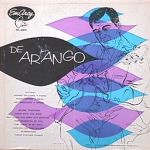 |

|
TamTam Books News
Saturday, January 14, 2006:


http://www.latimes.com/news/obituaries/la-me-dearango14jan14,0,6620497.story?coll=la-home-obituaries
From the Los Angeles Times
OBITUARIES
Bill DeArango, 85; Jazz Guitarist Was Part of Bebop Movement in '40s
From the Washington Post
January 14, 2006
Bill DeArango, an innovative jazz guitarist of the 1940s, died Dec. 26 at a nursing home in East Cleveland, Ohio. He had Alzheimer's disease and Parkinson's disease. He was 85.
Few guitarists were part of the revolutionary bebop movement led by saxophonist Charlie Parker and trumpeter Dizzy Gillespie until DeArango joined the New York jazz scene in 1944. He jumped into the lively nightclub action of 52nd Street, finding an immediate home with musicians who were taking jazz in bold new directions.
He was known for his lightning-fast runs, playing cascades of single notes that matched the speed and complexity of the saxophonists and pianists he modeled his playing after.
"I listened very closely to pianists and horn men as well as guitarists," he said in a 1996 interview with Guitar Player magazine. "I used to play along with Art Tatum's records, and Lester Young had a thing I wanted, playing out and intricate but still laid-back."
In 1946, Esquire magazine selected DeArango for its All-American Jazz Band and praised his "fleet, fevered single-string solo work."
He was in steady demand in nightclubs and recording studios in the mid-1940s and was a member of saxophonist Ben Webster's group from 1945 to 1947. He also led his own group, recording with an array of jazz stars, including vocalist Sarah Vaughan, saxophonist Don Byas and vibraphonists Milt Jackson and Red Norvo.
He performed on several early bebop recordings, including Parker's "Anthropology," Gillespie's "Night in Tunisia" and Thelonious Monk's "52nd Street Theme."
DeArango was born Sept. 20, 1921, in Cleveland and studied at Ohio State University.
While in a Dixieland band, he became drawn to the more progressive music of modern jazz.
Later, as he was gaining prominence as one of the premier guitarists of the bebop era, he grew irritated with increasing commercial pressures in music and abruptly left New York for Cleveland in 1948.
Except for occasional club work in his hometown and a well-received record he made in 1954, he all but dropped out of sight. During the 1960s and '70s, he ran a music store that became a center of the music scene in Cleveland.
Unlike many musicians of his generation, DeArango took a strong interest in rock music and adapted his style to fit the times.
Inspired by Jimi Hendrix, he attached a wah-wah pedal to his guitar to distort its tone. In 1993, he made his final recording, "Anything Went," a free-jazz romp with saxophonist Joe Lovano.
There are no known survivors.
Tosh // 10:49 AM
______________________

|
|
 |

|
The wonderful world of TamTam Books by publisher Tosh Berman
Archives
|
|
|



